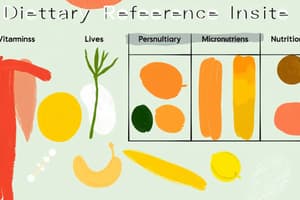Podcast
Questions and Answers
The maximum risk level for Vitamin A intake is 3,000 μg/d for adults aged 19-70 years.
The maximum risk level for Vitamin A intake is 3,000 μg/d for adults aged 19-70 years.
True (A)
The RDA for Vitamin C is 90 mg/d for women.
The RDA for Vitamin C is 90 mg/d for women.
True (A)
Water-soluble vitamins include Vitamins A and D.
Water-soluble vitamins include Vitamins A and D.
False (B)
Enrichment involves restoring nutrients lost during food processing to their original levels.
Enrichment involves restoring nutrients lost during food processing to their original levels.
The adequate intake of Vitamin D is 5 μg/d for both men and women aged 19-50 years.
The adequate intake of Vitamin D is 5 μg/d for both men and women aged 19-50 years.
Vitamin E has a tolerable upper intake level of 1,000 mg/d.
Vitamin E has a tolerable upper intake level of 1,000 mg/d.
Niacin has a recommended intake of 14 mg/d for men and 16 mg/d for women.
Niacin has a recommended intake of 14 mg/d for men and 16 mg/d for women.
B vitamins assist enzymes by acting as coenzymes, which are essential for energy release.
B vitamins assist enzymes by acting as coenzymes, which are essential for energy release.
Ultraviolet rays can decrease the riboflavin content in foods stored in transparent containers.
Ultraviolet rays can decrease the riboflavin content in foods stored in transparent containers.
Animal products have a consistent vitamin content regardless of their diet.
Animal products have a consistent vitamin content regardless of their diet.
Blanching vegetables stops all vitamin losses during processing.
Blanching vegetables stops all vitamin losses during processing.
Milling cereal grains does not affect the vitamin content of the bran.
Milling cereal grains does not affect the vitamin content of the bran.
Chemicals that affect pH can influence the stability of certain vitamins.
Chemicals that affect pH can influence the stability of certain vitamins.
Postharvest changes include enzymatic activities that affect vitamin content.
Postharvest changes include enzymatic activities that affect vitamin content.
Beta-carotene, found in fruits and vegetables, is an inactive form of vitamin A.
Beta-carotene, found in fruits and vegetables, is an inactive form of vitamin A.
Frozen vegetables are generally less nutritious than fresh ones.
Frozen vegetables are generally less nutritious than fresh ones.
Dry beriberi is characterized by damage to the cardiovascular system.
Dry beriberi is characterized by damage to the cardiovascular system.
Wernicke-Korsakoff Syndrome is primarily linked to chronic riboflavin deficiency.
Wernicke-Korsakoff Syndrome is primarily linked to chronic riboflavin deficiency.
Both dry and wet beriberi usually appear together with one set of symptoms predominating.
Both dry and wet beriberi usually appear together with one set of symptoms predominating.
Thiamin toxicity is commonly seen with normal dietary intake.
Thiamin toxicity is commonly seen with normal dietary intake.
Riboflavin is more stable than thiamin but is sensitive to light.
Riboflavin is more stable than thiamin but is sensitive to light.
Riboflavin, in its coenzyme form, can accept and donate three hydrogens.
Riboflavin, in its coenzyme form, can accept and donate three hydrogens.
Opaque containers are essential for selling milk to prevent riboflavin loss due to light exposure.
Opaque containers are essential for selling milk to prevent riboflavin loss due to light exposure.
Pork and whole grains are rich sources of thiamin.
Pork and whole grains are rich sources of thiamin.
Pellagra is characterized by the symptoms of diarrhea, dementia, dermatitis, and death.
Pellagra is characterized by the symptoms of diarrhea, dementia, dermatitis, and death.
A diet high in protein does not contribute to the development of pellagra.
A diet high in protein does not contribute to the development of pellagra.
Corn is an excellent source of niacin because it contains niacin that is freely available for absorption.
Corn is an excellent source of niacin because it contains niacin that is freely available for absorption.
Pellagra was initially thought to be caused by an infectious disease.
Pellagra was initially thought to be caused by an infectious disease.
Nicotinamide does not cause the 'niacin flush' that is often associated with large doses of nicotinic acid.
Nicotinamide does not cause the 'niacin flush' that is often associated with large doses of nicotinic acid.
Taking niacin supplements can harm patients with heart disease if used without monitoring.
Taking niacin supplements can harm patients with heart disease if used without monitoring.
Leucine promotes the conversion of tryptophan to niacin.
Leucine promotes the conversion of tryptophan to niacin.
The only recognized cause of diseases in the past was believed to be infectious agents.
The only recognized cause of diseases in the past was believed to be infectious agents.
Fat soluble vitamins are generally more bioavailable than water soluble vitamins.
Fat soluble vitamins are generally more bioavailable than water soluble vitamins.
Vitamins from plant foods are generally more bioavailable than those from animal foods.
Vitamins from plant foods are generally more bioavailable than those from animal foods.
Proper food preparation can affect the bioavailability of vitamins in food.
Proper food preparation can affect the bioavailability of vitamins in food.
Water soluble vitamins are less stable than fat soluble vitamins.
Water soluble vitamins are less stable than fat soluble vitamins.
Excess intake of vitamins is always beneficial for health.
Excess intake of vitamins is always beneficial for health.
The absorption of vitamins can depend on the fat content in the diet.
The absorption of vitamins can depend on the fat content in the diet.
Leaching into water is one of the primary ways water-soluble vitamins can be destroyed.
Leaching into water is one of the primary ways water-soluble vitamins can be destroyed.
The quantity of vitamins in fresh foods is always retained after processing.
The quantity of vitamins in fresh foods is always retained after processing.
NAD is primarily involved in energy-transfer reactions in carbohydrates, fats, and proteins.
NAD is primarily involved in energy-transfer reactions in carbohydrates, fats, and proteins.
The body can produce niacin from the amino acid leucine.
The body can produce niacin from the amino acid leucine.
A food with 1 milligram of niacin and 60 milligrams of tryptophan provides 1 niacin equivalent.
A food with 1 milligram of niacin and 60 milligrams of tryptophan provides 1 niacin equivalent.
Niacin is more prone to losses during cooking compared to other water-soluble vitamins.
Niacin is more prone to losses during cooking compared to other water-soluble vitamins.
Thiamin's coenzyme form is known as FAD.
Thiamin's coenzyme form is known as FAD.
Approximately 60 milligrams of dietary tryptophan is required to synthesize 1 milligram of niacin.
Approximately 60 milligrams of dietary tryptophan is required to synthesize 1 milligram of niacin.
Biotin can be synthesized by the body and does not require dietary intake.
Biotin can be synthesized by the body and does not require dietary intake.
Niacin is heat resistant and can withstand reasonable cooking times.
Niacin is heat resistant and can withstand reasonable cooking times.
Flashcards
What are vitamins?
What are vitamins?
Vitamins are organic compounds that are essential for normal growth and development. They are not produced by the body in sufficient amounts and must be obtained from the diet.
What is an essential nutrient?
What is an essential nutrient?
An essential nutrient is a nutrient required for health that the body cannot produce or produce in sufficient amounts, so it must be obtained from the diet.
What are fat-soluble vitamins and how are they stored?
What are fat-soluble vitamins and how are they stored?
Fat-soluble vitamins are stored in the body, primarily in the liver and adipose tissue. They are typically absorbed with dietary fat.
What are water-soluble vitamins and how are they absorbed in the body?
What are water-soluble vitamins and how are they absorbed in the body?
Signup and view all the flashcards
What is bioavailability?
What is bioavailability?
Signup and view all the flashcards
What factors influence bioavailability?
What factors influence bioavailability?
Signup and view all the flashcards
How are vitamins affected by processing and cooking?
How are vitamins affected by processing and cooking?
Signup and view all the flashcards
How do fat-soluble and water-soluble vitamins differ in stability?
How do fat-soluble and water-soluble vitamins differ in stability?
Signup and view all the flashcards
EAR (Estimated Average Requirement)
EAR (Estimated Average Requirement)
Signup and view all the flashcards
RDA (Recommended Dietary Allowance)
RDA (Recommended Dietary Allowance)
Signup and view all the flashcards
UL (Tolerable Upper Intake Level)
UL (Tolerable Upper Intake Level)
Signup and view all the flashcards
Restoration
Restoration
Signup and view all the flashcards
Fortification
Fortification
Signup and view all the flashcards
Enrichment
Enrichment
Signup and view all the flashcards
Water Soluble Vitamins (B & C)
Water Soluble Vitamins (B & C)
Signup and view all the flashcards
Coenzymes
Coenzymes
Signup and view all the flashcards
Inherent Variation in Vitamin Content
Inherent Variation in Vitamin Content
Signup and view all the flashcards
Postharvest Vitamin Losses
Postharvest Vitamin Losses
Signup and view all the flashcards
Vitamin Loss from Trimming and Peeling
Vitamin Loss from Trimming and Peeling
Signup and view all the flashcards
Vitamin Loss from Milling
Vitamin Loss from Milling
Signup and view all the flashcards
Blanching
Blanching
Signup and view all the flashcards
Impact of pH on Vitamins
Impact of pH on Vitamins
Signup and view all the flashcards
Oxidizing and Reducing Agents' Impact on Vitamins
Oxidizing and Reducing Agents' Impact on Vitamins
Signup and view all the flashcards
Vitamin Precursors
Vitamin Precursors
Signup and view all the flashcards
Wernicke-Korsakoff Syndrome
Wernicke-Korsakoff Syndrome
Signup and view all the flashcards
Dry Beriberi
Dry Beriberi
Signup and view all the flashcards
Wet Beriberi
Wet Beriberi
Signup and view all the flashcards
Thiamin Pyrophosphate (TPP)
Thiamin Pyrophosphate (TPP)
Signup and view all the flashcards
Flavin Adenine Dinucleotide (FAD)
Flavin Adenine Dinucleotide (FAD)
Signup and view all the flashcards
Flavin Mononucleotide (FMN)
Flavin Mononucleotide (FMN)
Signup and view all the flashcards
Beriberi
Beriberi
Signup and view all the flashcards
Thiamin RDA
Thiamin RDA
Signup and view all the flashcards
List the B Vitamins
List the B Vitamins
Signup and view all the flashcards
TPP
TPP
Signup and view all the flashcards
FAD and FMN
FAD and FMN
Signup and view all the flashcards
NAD
NAD
Signup and view all the flashcards
NADP
NADP
Signup and view all the flashcards
PLP
PLP
Signup and view all the flashcards
THF
THF
Signup and view all the flashcards
What is Pellagra?
What is Pellagra?
Signup and view all the flashcards
What role did diet play in the Pellagra epidemic in the US?
What role did diet play in the Pellagra epidemic in the US?
Signup and view all the flashcards
Why is the niacin in corn difficult to absorb?
Why is the niacin in corn difficult to absorb?
Signup and view all the flashcards
How does leucine relate to Pellagra?
How does leucine relate to Pellagra?
Signup and view all the flashcards
How was the cause of Pellagra discovered?
How was the cause of Pellagra discovered?
Signup and view all the flashcards
What are the effects of large doses of nicotinic acid?
What are the effects of large doses of nicotinic acid?
Signup and view all the flashcards
What is the potential benefit and risk associated with using niacin as a drug?
What is the potential benefit and risk associated with using niacin as a drug?
Signup and view all the flashcards
Which form of niacin does not cause 'niacin flush'?
Which form of niacin does not cause 'niacin flush'?
Signup and view all the flashcards
Study Notes
Water Soluble Vitamins (B & C)
- Eight water-soluble vitamins: B vitamin complex and vitamin C
- Four fat-soluble vitamins: vitamins A, D, E, and K
Vitamin Overview
- Vitamins are essential organic components of animal life's biochemical and physiological systems
- As animals evolved, they lost the ability to produce vitamins in adequate amounts in their bodies
- Vitamins usually occur in only tiny amounts in biological materials
- Their absence, lack of absorption, or insufficient dietary intake can cause a deficiency syndrome
Roles of Vitamins
- Promote growth and reproduction
- Support nutritional health
- Different from energy-yielding nutrients (do not provide energy)
- Composed of individual units, not complex structures
- Measured in micro/milligrams, not grams
- Are micronutrients
- Crucial amounts are needed, too much can be harmful
Vitamin Absorption and Storage
- All vitamin absorption takes place in the small intestine
- Fat-soluble vitamins are absorbed into the lymph system
- Storage: Vitamin A primarily stored in the liver; Vitamins K and E are partially stored in the liver; Vitamin D mainly stored in fat and muscle tissue
- Can accumulate in the body to toxic levels; therefore, food amounts are usually below daily values (DV) to avoid this
Vitamins: Bioavailability
- The amount of vitamins available from food is not just the amount of vitamin available but also the body's ability to absorb and use it
- Fat-soluble vitamins are less readily available than water-soluble vitamins
- Animal-derived vitamins are typically more readily available than plant-derived vitamins
Vitamins: Stability
- Fat-soluble vitamins are more stable than water-soluble vitamins
- Water-soluble vitamins can be destroyed by:
- Leaching into water
- Oxidation
- Irradiation (UV light)
- Heat
- Changes in pH
- Fresh foods naturally contain vitamins but can be destroyed by processing
- Prolonged heating damages vitamin content of some foods; certain foods lose riboflavin from light exposure
- Different factors can impact vitamin stability in food including processing techniques and storage conditions
Vitamins: Precursors
- Some vitamins are available in inactive forms called precursors or provitamins
- Precursors inside the body are converted to their active forms.
- Beta-carotene is a precursor for vitamin A
Vitamins: Comparison
| Feature | Water-Soluble Vitamins (B Vitamins and Vitamin C) | Fat-Soluble Vitamins (Vitamins A, D, E, and K) |
|---|---|---|
| Absorption | Directly into the bloodstream | First into the lymph, then into the blood |
| Transport Mechanism | Travel freely | Many require transport proteins |
| Storage | Circulate freely throughout the body fluid; excess is excreted into urine | Stored in fat-containing cells |
| Excretion | Excess is excreted via the kidneys in urine | Less readily excreted; tend to remain |
| Toxicity | Possible to reach toxic levels with supplements | Likely to reach toxic levels with supplements |
| Requirements | Needed in frequent doses | Needed in periodic doses |
Understanding Dose
- Dose-response curve: the relationship between the dose and observed effects
- Optimum dose: the point at which the effect is the strongest
Dietary Reference Intakes (DRIs)
- EAR (Estimated Average Requirement): 50% risk of deficiency
- UL (Tolerable Upper Intake Level): 0% risk of toxicity
Addition of Vitamins into Foods
- Restoration: Returning lost nutrients to original levels in foods
- Fortification: Adding nutrients to foods either lacking or having low quantities of them
- Enrichment: Increasing nutrient quantities above their original amounts in foods
The B Vitamins
- The body needs B vitamins for energy
- B Vitamins act as coenzymes assisting enzymes in energy release
B Vitamins (Specific examples)
- Thiamin (Vitamin B1): Part of coenzyme thiamin pyrophosphate (TPP); assists in energy metabolism; crucial for nerve and muscle activity
- Deficiency: Beriberi, Wernicke-Korsakoff syndrome - Toxicity: None reported
- Riboflavin (Vitamin B2): Serves as coenzyme in energy metabolism; more stable than thiamin
- Deficiency: Ariboflavinosis- Toxicity: None reported
- Niacin (Vitamin B3): Two chemical structures (nicotinic acid and nicotinamide); Two coenzyme forms participate in metabolic reactions
- Deficiency: Pellagra - Toxicity: Niacin flush (painful tingling); Can benefit heart disease patients, but must be monitored
- Pantothenic Acid (Vitamin B5): Part of coenzyme A involved in numerous metabolic processes; widespread in food, but readily destroyed by processing
- Deficiency: rare; symptoms may include fatigue, GI distress, and neurological disturbances- Toxicity: None reported
- Pyridoxine (Vitamin B6): Three forms that all convert to coenzyme PLP; Involved in numerous metabolic reactions
- Deficiency: Depression, confusion and convulsions - Toxicity: Nerve Damage
- Biotin (Vitamin B7): Coenzyme in metabolism; involved in gluconeogenesis, fatty acid synthesis, and amino acid breakdown
- Deficiency: rare- Toxicity: None reported
General Causes of Variation/Losses of Vitamins in Food
- 1- Inherent Variation: Vitamin content in food varies from factor such as stage of maturity, fertilizer, and climate (fruits and vegetables); biological mechanisms and diet of animal (animal products)
- 2- Postharvest Changes: Factors include enzymatic activities (oxidative and hydrolytic), physical damage, temperature abuse, length of time between harvest and processing, and chemical changes.
- 3- Preliminary Treatment: Trimming/peeling vegetables and fruits, washing and leaching, or loss of water-soluble vitamins from milling cereal grains (bran) impact nutrient availability
- 4- Blanching/Thermal Processing: Mild heat treatments inactivate enzymes and reduce microbial loads
- 5- Influence of Processing Chemicals and Food Components: Chemicals that change pH (e.g. ascorbic acid) or oxidizing/reducing agents can impact the stability of specific vitamins, thus affecting their bioavailability.
Studying That Suits You
Use AI to generate personalized quizzes and flashcards to suit your learning preferences.





